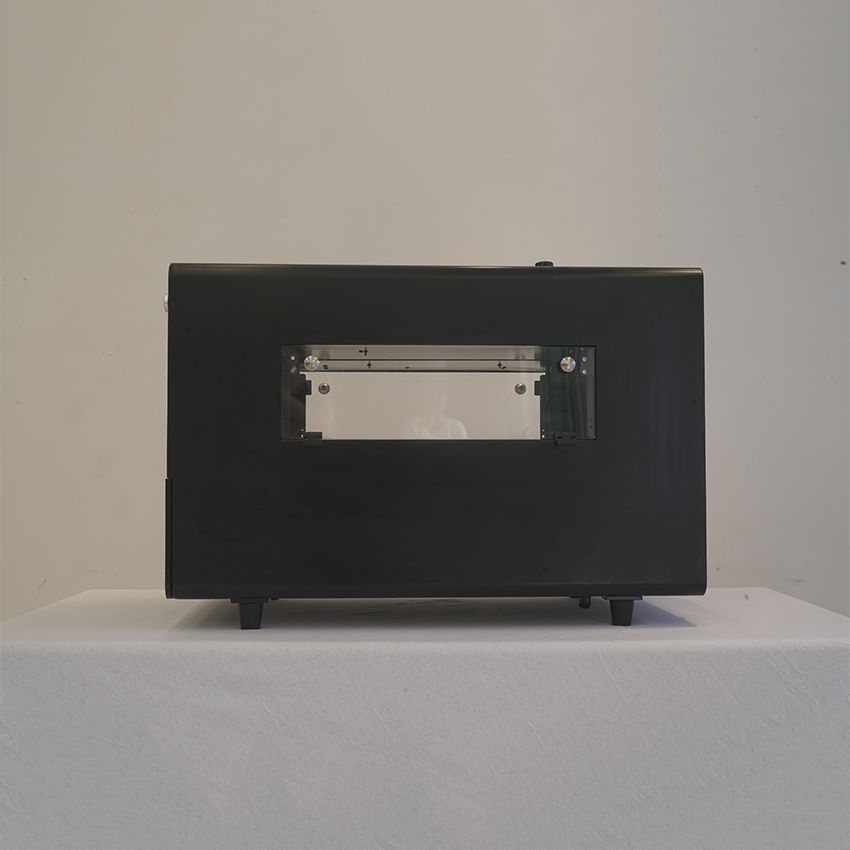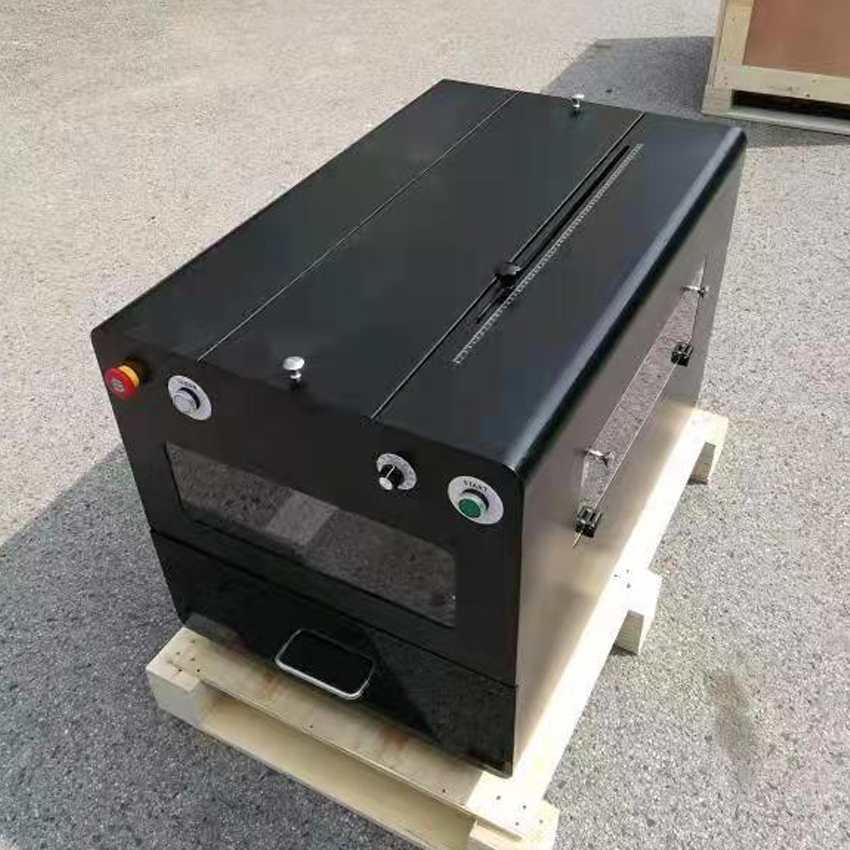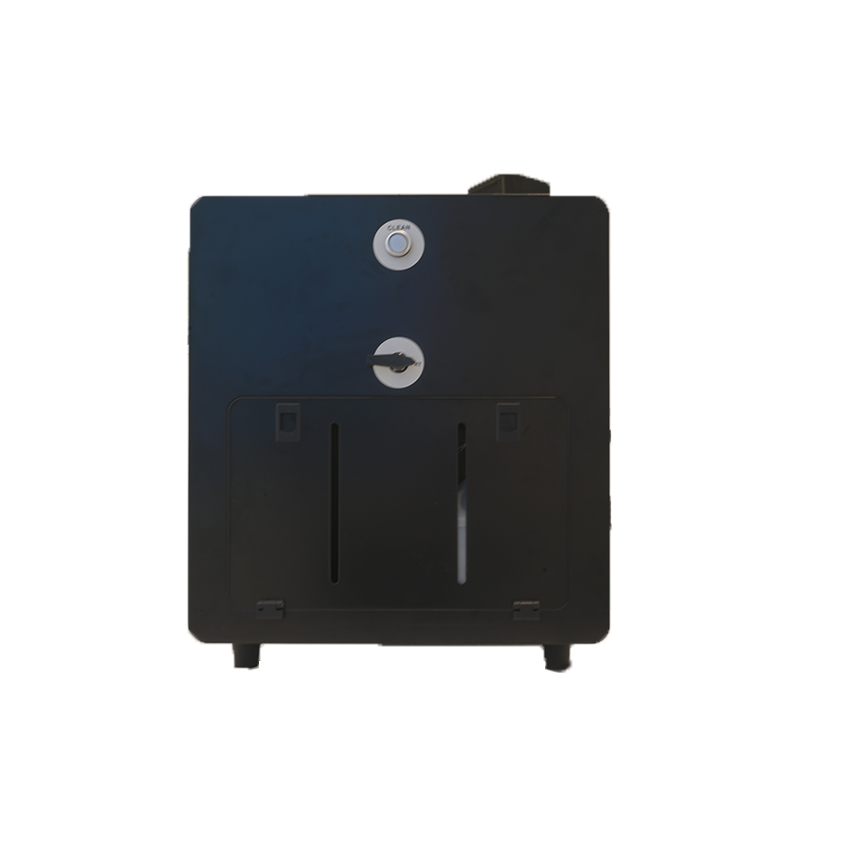The Perfect Partner To Improve DTG Printing Efficiency--Enclosed Spray Machine
The two main aspects of direct-to-garment digital printing (DTG) that clients are most concerned about are print quality and production efficiency. In addition to selecting a high-performance DTG industrial printer, the assistance of auxiliary equipment is essential for achieving high-quality pattern output and streamlining the manufacturing process. The Closed Spray Machine, a crucial piece of equipment for DTG post-printing processing, is an essential tool for contemporary printing facilities and may greatly increase the consistency and productivity of the pre-treatment liquid.
1.1 Principal use cases
Pretreatment with DTG white ink primer: guarantee that the design is vivid and adheres well to light or dark textiles.
Spraying colour fixer enhances printing's washability and keeps the design from fading or flaking off.
Special coating treatment: even application of antibacterial and waterproof functional coatings.

Depending on the model, high-speed spraying may produce 10–20 T-shirts per minute, significantly increasing manufacturing efficiency.
Waste reduction: The closed design may recover extra spray and use less pretreatment liquid.
Liquid circulation system: Some expensive versions have waste liquid recovery equipment that satisfies production criteria for environmental protection.
accommodates various pretreatment liquid formulations to satisfy client customisation requirements.
Automatic induction spraying: precise spraying initiation and cessation, waste avoidance, and clothing position detection by infrared or photoelectric sensors.
Multi-nozzle design: sprays without dead angles and covers the whole width of garments.
Modular architecture minimises downtime by making it simple to replace and maintain essential parts.
A waste liquid filtration system is an optional feature that satisfies green production standards.

(1) Uniformity of spraying
A closed spray machine uses an automatic control system and a precision atomising nozzle to guarantee that the pretreatment liquid covers the clothing's surface equally, prevents colour variations or unequal penetration, and produces reliable printing quality.
The ensuing printing result may be impacted by manual spraying, which depends on human labour and is prone to uneven spraying thickness, missing spraying, or excessive buildup.
Even though open spraying is more uniform than manual spraying, operator skill still plays a role and there may be some unevenness.
(2) Efficiency of production
Depending on the model, a closed spray machine may process 10–20 pieces of clothing per minute and is entirely automated, making it ideal for mass manufacturing.
Manual spraying is totally manual, has very low efficiency, can only process one to three pieces per minute, and is unable to meet medium- and large-scale production demands.
Open spray guns are more effective than manual spraying, but they still need to be operated by hand. They may spray five to ten pieces per minute, and prolonged use can quickly cause tiredness.
(3) Level of reliance on manual labour
Closed spray machine: hardly any physical labour, highly automated, just needs garments to be placed.
Spraying by hand: the entire procedure depends on physical labour, which is expensive and hard to standardise.
Open spray guns need to be sprayed by hand, which calls for a certain level of skill.
(4) Rate of liquid waste
Closed spray machine: By recycling excess spray with a waste rate of less than 5%, the closed design reduces the need for pretreatment liquid.
Spraying by hand: Accurately controlling the spraying volume is challenging, and the waste rate might reach 20% to 30%.
An open spray pistol has a 15%–20% waste rate, with some spray drifting into the air.
(5) Safety of the environment
Closed spray machine: Totally enclosed construction to avoid chemical gas volatilisation, safeguard the health of employees, and adhere to environmental regulations.
Spraying by hand: Open operation presents a safety risk since chemical gases and liquids can easily come into touch with human tissue.
Open spray gun: The working environment is unfavourable, there is a lot of spray overflow, and prolonged use may harm respiratory health.
Standard closed spray machines with a processing capability of 10–15 pieces per minute are advised for medium-sized printing facilities.
Large production lines: fully automated high-speed models that can handle more than 20 items per minute and have an integrated conveyor belt system must be chosen.
Control system: prioritise memory-capable smart panels to make it easier to store various process parameters.
After-sales service: To guarantee reliable, long-term use, pick brands that offer technical assistance and accessories.
AI intelligent adjustment: use machine learning to optimise spraying parameters to accommodate varying fabric properties.
Integration of the Internet of Things (IoT) allows for intelligent production management and remote equipment condition monitoring.
More ecologically friendly spraying techniques, include using low-volatile pretreatment fluids and water-based coatings

1. What is a closed spray machine?
For the DTG printing process, the closed spray machine is an automated liquid pretreatment spraying device. To guarantee that the pretreatment liquid (such as colour fixer or white ink primer) is precisely and uniformly applied to the textile surface, it uses a closed spray system. Closed spray machines are particularly well-suited for mass production in medium and large printing plants, and they offer notable advantages in terms of speed, consistency, and environmental protection when compared to open spray guns or traditional human spraying.1.1 Principal use cases
Pretreatment with DTG white ink primer: guarantee that the design is vivid and adheres well to light or dark textiles.
Spraying colour fixer enhances printing's washability and keeps the design from fading or flaking off.
Special coating treatment: even application of antibacterial and waterproof functional coatings.

2. The main benefits of closed spraying equipment
2.1 Printing quality is enhanced by uniform spraying.
Conventional manual spraying frequently results in an uneven pretreatment liquid dispersion, which can alter the printing impact later on. The closed spraying machine improves the yield of DTG printing by using automatic control systems and precision atomising nozzles to guarantee that the coating thickness on the surface of every article of clothing is uniform, preventing colour variations or uneven penetration.2.2 Labour cost savings and effective automation
Completely automated operation: The machine may finish spraying without human assistance if you simply lay the clothing flat on the conveyor belt.Depending on the model, high-speed spraying may produce 10–20 T-shirts per minute, significantly increasing manufacturing efficiency.
Waste reduction: The closed design may recover extra spray and use less pretreatment liquid.
2.3 Safety and environmental preservation, enhancing the working environment
Closed structure: effectively reduces chemical gas volatilisation, prevents spray overflow, and safeguards operator health.Liquid circulation system: Some expensive versions have waste liquid recovery equipment that satisfies production criteria for environmental protection.
2.4 Excellent compatibility, appropriate for a range of textiles
Adjustable spray pressure and volume make it appropriate for a range of textiles, including mixed fabrics, cotton, and polyester.accommodates various pretreatment liquid formulations to satisfy client customisation requirements.
3. The closed spray machine's primary technical performance
3.1 A system of intelligent control
Users can freely change parameters like conveyor belt speed and spray volume using the touch screen operation interface.Automatic induction spraying: precise spraying initiation and cessation, waste avoidance, and clothing position detection by infrared or photoelectric sensors.
3.2 Effective technology for atomisation spraying
A high-pressure atomisation nozzle guarantees even spraying and fine liquid particles.Multi-nozzle design: sprays without dead angles and covers the whole width of garments.
3.3 A sturdy and dependable mechanical framework
The body is made of stainless steel, which resists corrosion and is appropriate for prolonged high-load use.Modular architecture minimises downtime by making it simple to replace and maintain essential parts.
3.4 Eco-friendly and energy-efficient design
A low-power motor uses less energy.A waste liquid filtration system is an optional feature that satisfies green production standards.

4. A comparison of the effectiveness of closed spray machines and conventional spraying techniques
The quality of the final product and the efficiency of manufacturing will be directly impacted by the variation in spraying technique used during the DTG printing pretreatment stage. A thorough comparison of closed spray machines and conventional spraying techniques (manual spraying and open spray guns) is provided below:(1) Uniformity of spraying
A closed spray machine uses an automatic control system and a precision atomising nozzle to guarantee that the pretreatment liquid covers the clothing's surface equally, prevents colour variations or unequal penetration, and produces reliable printing quality.
The ensuing printing result may be impacted by manual spraying, which depends on human labour and is prone to uneven spraying thickness, missing spraying, or excessive buildup.
Even though open spraying is more uniform than manual spraying, operator skill still plays a role and there may be some unevenness.
(2) Efficiency of production
Depending on the model, a closed spray machine may process 10–20 pieces of clothing per minute and is entirely automated, making it ideal for mass manufacturing.
Manual spraying is totally manual, has very low efficiency, can only process one to three pieces per minute, and is unable to meet medium- and large-scale production demands.
Open spray guns are more effective than manual spraying, but they still need to be operated by hand. They may spray five to ten pieces per minute, and prolonged use can quickly cause tiredness.
(3) Level of reliance on manual labour
Closed spray machine: hardly any physical labour, highly automated, just needs garments to be placed.
Spraying by hand: the entire procedure depends on physical labour, which is expensive and hard to standardise.
Open spray guns need to be sprayed by hand, which calls for a certain level of skill.
(4) Rate of liquid waste
Closed spray machine: By recycling excess spray with a waste rate of less than 5%, the closed design reduces the need for pretreatment liquid.
Spraying by hand: Accurately controlling the spraying volume is challenging, and the waste rate might reach 20% to 30%.
An open spray pistol has a 15%–20% waste rate, with some spray drifting into the air.
(5) Safety of the environment
Closed spray machine: Totally enclosed construction to avoid chemical gas volatilisation, safeguard the health of employees, and adhere to environmental regulations.
Spraying by hand: Open operation presents a safety risk since chemical gases and liquids can easily come into touch with human tissue.
Open spray gun: The working environment is unfavourable, there is a lot of spray overflow, and prolonged use may harm respiratory health.
5. How can one select an appropriate closed spray machine?
5.1 Select a model based on the necessary production capacity.
Desktop or semi-automatic variants with a processing speed of roughly 5–10 pieces per minute are available for small studios.Standard closed spray machines with a processing capability of 10–15 pieces per minute are advised for medium-sized printing facilities.
Large production lines: fully automated high-speed models that can handle more than 20 items per minute and have an integrated conveyor belt system must be chosen.
5.2 Pay attention to the basic configuration
Nozzle material: ceramic or premium stainless steel nozzles are more resilient.Control system: prioritise memory-capable smart panels to make it easier to store various process parameters.
After-sales service: To guarantee reliable, long-term use, pick brands that offer technical assistance and accessories.
6. Trends for closed spray machine development in the future
Closed spray machines are also constantly being improved as DTG printing technology advances towards more efficiency and greener paths:AI intelligent adjustment: use machine learning to optimise spraying parameters to accommodate varying fabric properties.
Integration of the Internet of Things (IoT) allows for intelligent production management and remote equipment condition monitoring.
More ecologically friendly spraying techniques, include using low-volatile pretreatment fluids and water-based coatings

RECENT POSTS
-
Open spray machine: the perfect supporting equipment to improve the efficiency of DTG industrial printers
-
The Perfect Partner To Improve DTG Printing Efficiency--Enclosed Spray Machine
-
Industrial Printer Maintenance Guide: Keep Your Equipment Running Smoothly
-
Which Printing Type is the Most Cost-Effective for Large Print Jobs?
-
What Is The Difference Between Wide Format And Large Format?
Application
-
 Application scenarios of UV DTF printersUV DTF printer is our NEW machine, which is loved by many consumers.crystal stickers are widely used.
Application scenarios of UV DTF printersUV DTF printer is our NEW machine, which is loved by many consumers.crystal stickers are widely used.
Crystal stickers can also be used as decorations to make your gift more beautiful and special. -
 UV DTF Printer Client FeedbackA customer from Austria placed an order for our UV DTF printer after many inspections. This is their feedback after using it.
UV DTF Printer Client FeedbackA customer from Austria placed an order for our UV DTF printer after many inspections. This is their feedback after using it.
More Application












